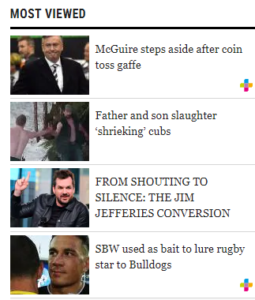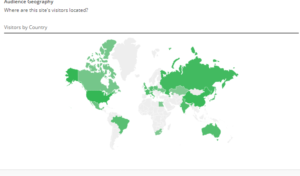
The Daily Telegraph: ‘Million’ march for new Brexit referendum
Launched in 1879 under the name of its predecessor The Tele, The Daily Telegraph is an Australian daily tabloid newspaper published in Sydney, New South Wales. It is an established online news service run by Nationwide News Limited which is a part of News Corp Australia. In 1927, it changed from a broadsheet to tabloid format, returned to a broadsheet form in 1931, and ultimately switched to a tabloid format in 1942. As one of Australia’s fastest updating news platforms, it is committed to building breaking news brand, along with live streaming service.
Despite the global content, The Daily Telegraph mainly focus on the news story which takes place in Australia, especially Sydney, New South Wales. “The Daily Telegraph is the voice of Sydney and NSW.” (About Us, The Daily Telegraph) Therefore, its target audience is Australian. According to Alexa, More than 70 per cent of their traffic is from within the country.

dailytelegraph.com.au Traffic Statistics, Alexa.

Journalistic Content
The headline of the news is brief and concise with the use of “million” which will attract the audience’ attention and allow them to get the story quickly. The reporter seeks to remain fair and display balance (Eldridge & Franklin, 2017). Although the march comes with public outrage and political colour, the news story is reported based on facts by using active and direct language without emotive words and personal comments on this event. Although it is a long-form story, each paragraph is short. Shorter pieces work better online because briefly is essential to report the story by rule and line (Bradshaw, 2018).
As for protestor’ reaction, The journalist makes it clear that marchers claim to oppose Brexit and hold another referendum through interviewing two marchers Gareth Rae and Phoebe Poole. The quotations from the interviewees enhance the reliability of the story and increase readers’ engagement. However, the lead just repeats the headline and fail to sum up further information. It would be better to mention that the march is in one of the biggest demonstrations in British history in the lead to arouse the reader’s interest.
Multimedial, Hypertextual and Interactive
It is a piece of breaking news posted on March 24 which is a Sunday, so that it has only one image, no links and no reporter biographies. This means that there is no image for the long text to break down apart from one blurred picture at the start of the story. Also, the story has no links to relevant stories about Brexit for the audience to understand the background of it. The links that can be found on the right side of the page is MOST VIEWED stories which are irrelevant and do not open a new page for readers so that they are not likely to go back to the original story. Links to previous stories about the Brexit extension petition and Brexit referendum would be useful for the reader. More images of the march would also attract increased views. Mixing text with other media will draw readers’ eyes down the page and engage them longer (Bradshaw. 2018).
The story can be shared on social platforms Facebook and Twitter and through email, but it does not have a comments section for readers to exchange opinions, which reduces the interaction between readers and the page.

Functionality and accessibility
Although the page is less functional due to the lack of links to other Brexit referendum stories, the using of keywords such as “Brexit” makes it easy for readers to find the story. Bradshaw suggests that a clear layout is one of web writing strategies. The menu on the top of the page can take users to where they are interested in. It also includes the subscribe button, the newsletter registration field for the reader to take certain actions. However, there is no caption for the picture and it only describes what the picture is about.
Wikinews: Thousands march in anti-Brexit protest, London
Founded in 2004 and operated and supported by the Wikimedia Foundation, Wikinews is a participatory news site in which the public is able to intervene in published content. It is based on the Wiki system and the principle of collaboration among amateur reporters. According to Wikinews, “Anyone can contribute, and articles are written collaboratively for a global audience. ”(About Us, Wikinews). Like Wikipedia, it is run and funded by volunteers without the revenue of advertising. Wikinews allows isolated individuals and interest groups to contribute stories by submitting their own journalistic material, editing texts, commenting and discussing changes made by other collaborators (Träsel, 2008). Bradshaw(2018) points out that participative web journalism allows users to create content and recruit the story collaboratively. Due to the difference of the reader’s educational background, the Wikinews Guide points out that news stories must be written from a neutral point of view and based on facts to maintain the quality of news stories. Besides, it is possible for the text to return to a previous version in case of error or vandalism because each Wikinews story comes with a history of changes.
According to Alexa, Wikinews website is most frequented by visitors located in the United States, Russia and Japan. Among them, the United States has a higher percentage which is 15.5 per cent specifically. As it encourages readers to contribute stories and join in the discussion, people in favour of creating content of news are also its target audience.


Journalistic Content
Compared to The Daily Telegraph, the headline is less shocked. It also opens the first paragraph by repeating the headline that a crowd estimated at over one million people marched to demand a fresh referendum on Brexit. It adopts a unique structure of publishing story that the images are below the text as an independent section. Short paragraphs make it easy for readers to digest and capture the primary information of the story. However, instead of providing a brief introduction and the name of interviewees and participants, the story cites from interviewees by using “Some of the protesters Wikinews interviewed” , “One interviewee said” and “One MP told the BBC”, which severely undermines the story’s credibility. Also, Wikinews delineated less background information about Brexit in the text than The Daily Telegraph did.

Multimedial, Hypertextual and Interactive
The Wikinews has included links to related Brexit stories which provide a fairly good overview of the story to date. The linked stories are organised by a timeline which is clear for the reader to understand the background of the story according to the time they occurred. However, it would be more attracting to provide these stories with a featured image. Eighteen images of marchers carrying placards and European Union flags give the reader a comprehensive scenario and a sense of involvement. It is a marketing tool for distributing news on social media platforms (Michael Karlsson & Christer Clerwall, 2015). On the story page, users can share it through a variety of online platforms such as Facebook and Digg.com, while the Daily Telegraph can be only shared by three mainstream platforms: Facebook, Twitter and Email.

Thousands march in anti-Brexit protest, London, Wikinews.
Functionality and accessibility
Overall, the page is highly functional. Upon entering the story’s page, the cybernaut is shown a headline, followed by the text below. A menu in the top right corner offers links to lists of Brexit news in the UK. Above the headline, there is a text box with pointers linking to “related articles”, to pages about how to participate and start an article. In the left column, there is a navigation menu, users can easily find what they are searching for. It displays Bradshaw’s (2018) web writing principles of scannability. However, the layout of the page is compact; designing a more concise page will make it easy for users to read. Besides, there is an inconvenience for the readers that those links open in the same page, thus moving them away from the original story.
Reference
‘About Us’The Daily Telegraph. Available at https://www.dailytelegraph.com.au/help/about [Accessed 20 March 2019]
Eldridge, S. A., & Franklin, B. (2017). The Routledge companion to digital journalism studies. London ; New York: Routledge.
Bradshaw, P. (2018). Writing for the Web. In The Online Journalism Handbook: Skills to survive and thrive in the digital age (pp. 72–98). Routledge.
Träsel, M. (2008). Grassroots online journalism: Public intervention in Kuro5hin and Wikinews. Brazilian Journalism Research, 4(2), 69–87. https://doi.org/10.25200/BJR.v4n2.2008.150
Bradshaw, P. (2018). Histories, futures and the changing business and technologies of online journalism. In Online Journalism Handbook: Skills to survive and thrive in the digital age (pp. 5–50). Routledge.
ISBN: 978-1-138-79156-5
‘Introduction to Wikinews’ Wikinews. Available at https://en.wikinews.org/wiki/Wikinews:Introduction [Accessed 20 March 2019]
‘Policies and guidelines’ Wikinews. Available at https://en.wikinews.org/wiki/Wikinews:Policies_and_guidelines [Accessed 20 Mrch 2019]
Michael Karlsson, A. B., & Christer Clerwall, K. F. (2015). Participatory journalism – the (r)evolution that wasn’t. Content and user behavior in Sweden 2007–2013. Journal of Computer‐Mediated Communication, 20(3), 295–311. doi:10.1111/jcc4.12115

Be the first to comment